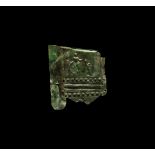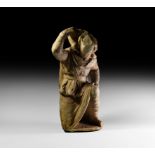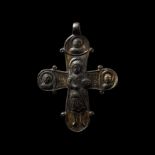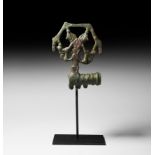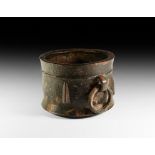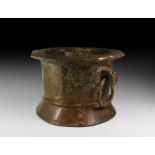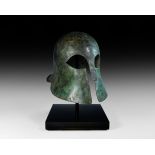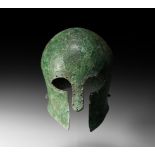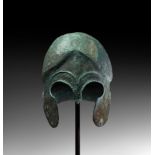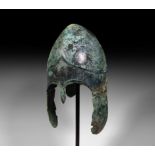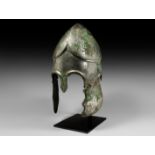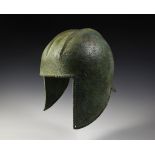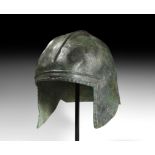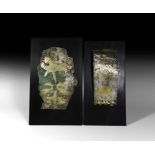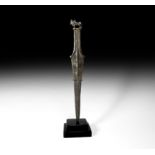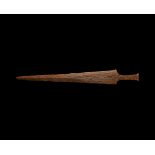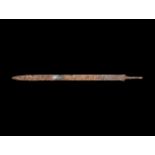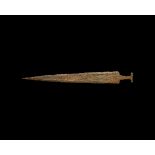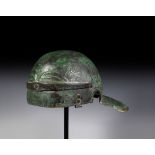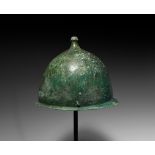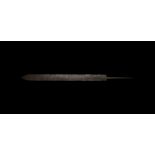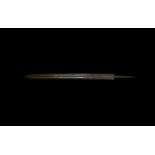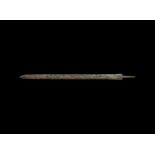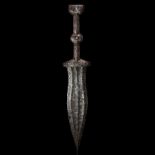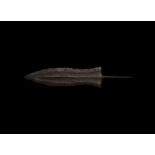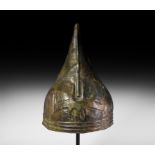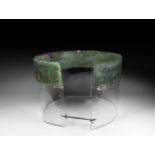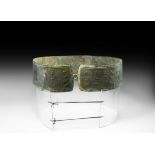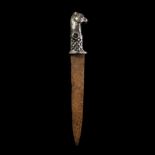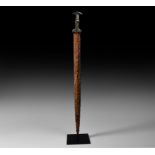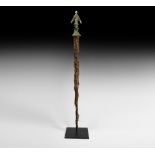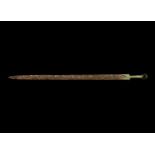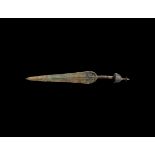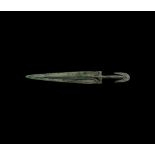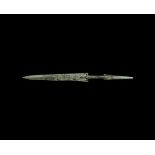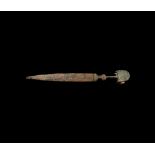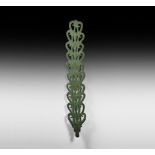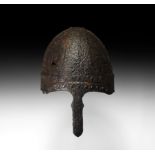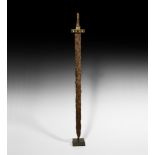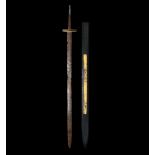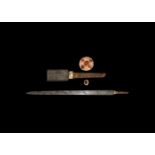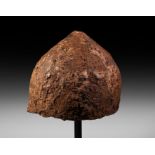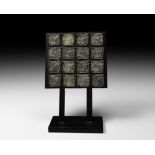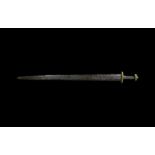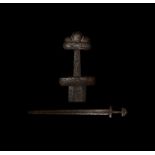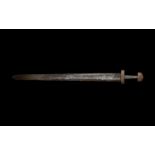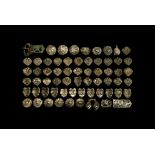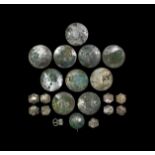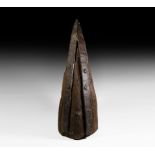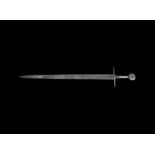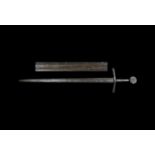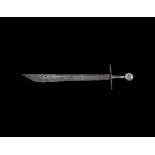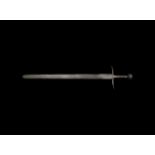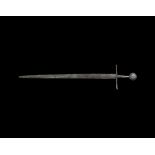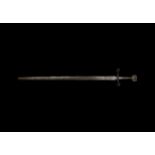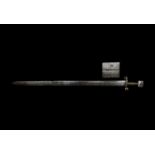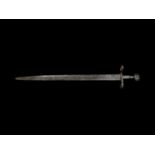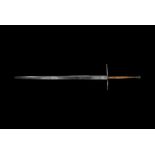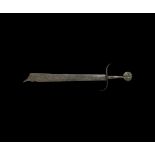Refine your search
Filtered by:
- Category
- List
- Grid
A subscription to the Price Guide is required to view results for auctions ten days or older. Click here for more information
3rd century AD. A sheet-bronze section of parade armour with low-relief scene depicting Eros offering a Corinthian helmet(?) to a warrior or godde...
2nd century AD. A marble statue of a barbarian prisoner, presumably a Parthian warrior, depicted kneeling on his right knee, his right arm raised ...
14th century AD. A silver-gilt cross engraved with a standing figure of St George in the centre, fully armoured and wearing a epilórikion (cuirass...
13th-7th century BC. A ceremonial bronze axehead with socket in the form of an animal head with three studs along back face to receive a haft havi...
12th-13th century AD. A substantial bronze mortar with slightly convex base, straight sides and wide rim; four vertical teardrop ribs decorating t...
11th-12th century AD. A heavy bronze mortar with flared base, straight sides, and everted octagonal rim; two attachment lugs to either side of the...
6th century BC. A spectacular bronze helmet of Corinthian typology raised from a single sheet, strong nose guard with rounded end, large eye openi...
Greek Corinthian Helmet
Late 7th-mid 6th century BC. A substantial bronze helmet of domed form, raised from a single sheet, large eye openings and arched cheek protection...
Greek Chalcidian Helmet
5th century BC. A bronze helmet of Chalcidian type 2 variant, the crown with carinated perimeter, deep crescentic cheekpieces with small rings for...
Greek Pontic Chalcidian Helmet
4th century BC. A bronze helmet of Chalcidian typology, the bowl forged from one piece with carination to the skull, long nasal with flared rim, f...
Greek Tinned Chalcidian Helmet
5th-4th century BC. A highly tinned 'silvered' helmet of Chalcidian type, the bowl forged in one piece with strong ridge and horizontal neck prote...
Late 7th-mid 6th century BC. A hemispherical helmet raised from a single sheet of bronze, contoured crest base formed of two parallel raised ridge...
Late 7th-mid 6th century BC. A bronze helmet raised from a single sheet, hemispherical skull with contoured crest base formed of two parallel corr...
Magyar Horse Chamfron Plaques
9th century AD. A pair of silver-gilt plaque fragments: one a square fragment with gilt images of a ram and sheep, rivetted clasps to short edges ...
6th-5th century BC. A bronze two-edged dagger comprising a triangular blade with midrib extending to the rounded tip, flat-section grip with denti...
4th century BC. An iron akinakes sword of Central Asian typology, strong hilt, narrow ogival guard with Steppe style ornamentation, tipped hilt, t...
Sarmatian Spatha Sword
4th-5th century AD. An iron two-edged longsword or spatha with lentoid-section blade, shoulder slightly flared, tapering neck and narrow tang with...
4th century BC. An iron akinakes sword of Central Asian typology, strong hilt, narrow ogival guard incorporated in the blade, tipped hilt, triangu...
1st-2nd century AD. A relatively heavy bronze legionary helmet, consisting of embossed skull and wide neck-guard with flanged ear-guards, traced e...
1st century BC-1st century AD. A relatively light bronze legionary helmet with bulbous domed bowl, small crest knob with flattened top, pierced at...
Roman Gladius Long Sword
Mid 1st-mid 3rd century AD. A double-edged iron sword of Pompeii typology with parallel cutting edges tapering towards the triangular point, battl...
Circa 300 AD. A double-edged spatha long sword of Illerup-Wyhl typology with excellently preserved blade, three blood channels running along its l...
Roman 'Herulian' Spatha Sword
5th-7th century AD. A double-edged spatha with a parallel-sided iron blade and well preserved pointed tip; battle nicks on both cutting edges; the...
1st century BC-1st century AD. An iron military pugio dagger of period II, with prominent and rich decoration, comprising a short lanceolate blade...
Roman Pugio Dagger
Mid 3rd century AD. An iron short dagger or pugio of 'Kunzing Type', with double-edged blade, the blade characteristically leaf-shaped with pronou...
Early 8th century BC. A broad hammered bronze helmet of conical form, produced from a single sheet of metal, the front with a raised linear motive...
8th-7th century BC. A broad hammered bronze military belt or cuirass band, the register decorated in chased low-relief with hunting scenes includi...
7th century BC. A broad hammered bronze military belt or cuirass band, the register decorated in chased low relief with hunting scenes including g...
Achaemenid Silver Hilted Dagger
6th century BC. An iron dagger with hilt clad in sheet-silver and shaped as the head and neck of a horse, the mane of the horse in low-relief, lar...
Luristan Sword with Bronze Hilt
13th-7th century BC. An iron short sword with slender double-edged blade and pointed tip; bronze handle with narrow lower guard with incised chevr...
8th-7th century BC. A long sword with double-edged iron lentoid-section blade, bronze hilt with scooped lower guard, three beaded collars, pommel ...
Luristan Sword with Bronze Hilt
13th-6th century BC. A sword comprising a two-edged lentoid-section iron blade with rounded tip, narrow shoulders encased in a bronze sleeve exten...
Sword with Blood Channels
2nd millennium BC. A substantial bronze short sword with broad triangular, double-edged blade and central midrib; crescent guard to the shoulders;...
1st millennium BC. A substantial bronze sword with leaf-shaped blade with rounded shoulders, raised midrib with fullers and curved ends extending ...
1st millennium BC. A bronze short sword comprising a broad triangular two-edged blade with median panel developing to a midrib above the point, lo...
8th-7th century BC. A sword with leaf-shaped iron blade, double-waisted grip with transverse collar, the pommel formed as two crescentic iron spay...
4th century BC. A bronze openwork horse frontlet with the lower part shaped as a stylised head of a horse, incised detail to front surfaces includ...
6th-7th century AD. A segmented iron helmet formed from overlapping and rivetted sheets, two upper bands forming a cross running front-to-back and...
5th century AD. A double-edged sword with broad pointed tip, battle nicks to both cutting edges and traces of scabbard to blade; the gilt lower gu...
5th-6th century AD. An iron two-edged cavalry spatha sword with a parallel-sided blade with broad pointed tip, battle nicks to both cutting edges;...
6th century AD. A spatha longsword and scabbard fitting; the iron blade lentoid in section with parallel edges and tapering tip, formed by the for...
4th-5th century AD. An iron two-edged sword with parallel-sided blade with pointed tip, battle nicks to both cutting edges; the tang retaining one...
Norman Four-Plate Helmet
11th-12th century AD. A Norman or Cuman four-plate iron helmet constructed from curved triangular sections converging at the apex; the bowl contou...
8th-10th century AD. A group of twelve square silver-gilt plaques from a belt or baldric, each with a low-relief Borre Style pair of 'gripping bea...
10th century AD. A superb Anglo-Scandinavian double-edged cutting sword of Petersen Type L or O variant, straight tapering blade with rounded poin...
10th-early 11th century AD. A double-edged cutting sword of Petersen Type S variant and Wheeler Type III with long tapering blade, battle nicks to...
Viking Sword with Inlaid Hilt
Early 10th century AD. An iron Viking period sword comprising a broad double-edged blade of Peirce's Type 1 with shallow fullers and rounded tip; ...
9th-10th century AD. A group of sixty-two silver belt fittings comprising a buckle with pentagonal plate decorated with spiral twigs; thirteen fit...
8th-9th century AD. A large group of substantial silver horse harness fittings from the Khazar Empire, composed of ten round phalerae, presumably ...
Medieval Battering Ram Tip
14th-15th century AD. A large and heavy tip of a battering ram formed from a mature tree trunk, trimmed to a point and fitted with a blacksmith-ma...
Mid 11th-mid 13th century AD. An iron sword with two-edged blade, gently tapering profile with rounded point, shallow fuller, parallel-sided strai...
12th-early 13th century AD. A western long double-edged sword with tapering blade, the cutting edges with evidence of use on the battlefield; both...
13th century AD. An iron falchion with single-edged, asymmetric blade, with short back edge, surface littered with one hole and some signs of corr...
Medieval Single-Handed Sword
14th-15th century AD. An iron sword of pre-schiavonesca type with straight blade, no fullers, round tip, the S-curved cross-guard of 12a type, tap...
15th century AD. An iron double-edged sword of Oakeshott Type XVIIIa with fairly slender blade of flattened diamond-section form, narrow fuller, h...
Medieval Schiavonesca Type Sword
15th century AD. A bastard or hand-and-a-half sword of the schiavonesca type; blade with battle-nicks to both faces and parallel-sides with rounde...
Mid 15th century AD. A long-bladed sword of schiavonesca type with broad double-edged blade, parallel-sided with long triangular point and acute t...
15th century AD. An iron schiavonesca type Z sword with parallel double-edged blade of lenticular section, with rounded tip, slightly enlarged at ...
Late 16th century AD or earlier. A colossal two-handed sword, possibly of German workmanship, straight double-edged blade with wide and shallow bl...
Tudor Falchion with Stamped Tang
Late 16th century AD. A single-edged, heavy cross-section late falchion, the iron blade without fuller to each face; possible maker's mark made of...

